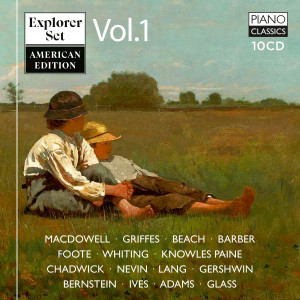Charles Tomlinson Griffes
Story
Charles Tomlinson Griffes (September 17, 1884 – April 8, 1920) was an American composer for piano, chamber ensembles and voice. Griffes was born in Elmira, New York. After early studies on piano and organ in his home town, he went to Berlin to study with pianist Ernst Jedliczka at the Stern Conservatory.[2] While there, Griffes also enjoyed a brief but influential mentorship by composer Engelbert Humperdinck.[2] On returning to the U.S. in 1907, he became director of music studies at the Hackley School for boys in Tarrytown, New York, a post which he held until his early death thirteen years later.
Griffes is the most famous American representative of musical Impressionism. He was fascinated by the exotic, mysterious sound of the French Impressionists, and was compositionally much influenced by them while he was in Europe. He also studied the work of contemporary Russian composers (for example Scriabin), whose influence is also apparent in his work, for example in his use of synthetic scales.
His most famous works are the White Peacock, for piano (1915, orchestrated in 1919); his Piano Sonata (1917–18, revised 1919); a tone poem, The Pleasure Dome of Kubla Khan, after the fragment by Coleridge (1912, revised in 1916), and Poem for Flute and Orchestra (1918). He also wrote numerous programmatic pieces for piano, chamber ensembles, and for voice. The amount and quality of his music is impressive considering his short life and his full-time teaching job, and much of his music is still performed. His unpublished Sho-jo (1917), a one-act pantomimic drama based on Japanese themes, is one of the earliest works by an American composer to show direct inspiration from the music of Japan.
Griffes died of influenza in New York City during the worldwide pandemic at the age of 35 and is buried in Bloomfield Cemetery in Bloomfield, New Jersey.[4] His papers passed to his younger sister Marguerite, who chose to destroy many that explicitly related to his life as a homosexual.[5] Donna Anderson (see below) is his current literary executor.
Griffes kept meticulous diaries, some in German, which chronicled his musical accomplishments from 1907 to 1919, and also dealt honestly with his homosexuality, including his regular patronage of the Lafayette Place Baths and the Produce Exchange Baths.
Charles Tomlinson Griffes was drawn into the gay world by the baths not just because he had sex there, but because he met men there who helped him find apartments and otherwise make his way through the city, who appreciated his music, who gave him new insights into his character, and who became his good friends. The gay world became a central part of his everyday world, even though he kept it hidden from his nongay associates.— George Chauncey, Gay New York 1995
During his time as a student in Berlin he was devoted to his “special friend” Emil Joèl (aka “Konrad Wölcke”). In later life, he had a long term relationship with John Meyer (biographer Edward Maisel used the pseudonym Dan C. Martin), a married New York policeman.
Details
- Composer
- Charles Tomlinson Griffes
- Date of birth
- September 17, 1884
- Nationality
- American
- Albums
- 2
- Tracks
- 32
2 albums
-

Samuel Barber, Charles Tomlinson Griffes and 8 others
Explorer Set: The American Edition, Vol. 1
-

Charles Tomlinson Griffes
Griffes: The Vale of Dreams, Piano Music
